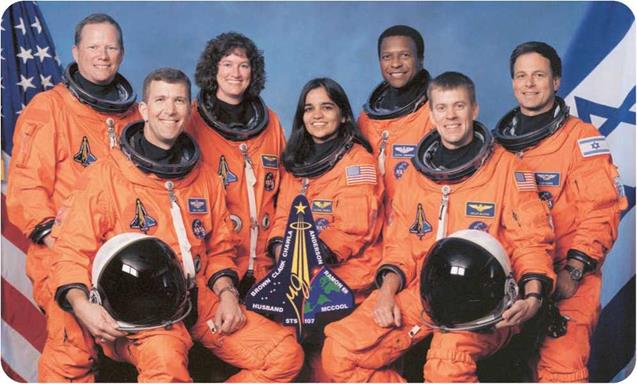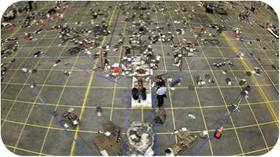Columbia Reentry
Back in 1981, Columbia had been the first Space Shuttle to go into space. The tragic accident on February 1, 2003, that destroyed the spacecraft and claimed the lives of its crew took place at the end of its twenty-eighth mission.
While Columbia was still in space, engineers studied video images of its launch. The images showed a piece of insulating foam falling off the external fuel tank and hitting Columbia’s left wing 82 seconds after liftoff. It was not a serious concern at the time. When Columbia began its return to Earth from space, however, it began to heat up. As Columbia hurtled deeper into the atmosphere, ground controllers noticed that sensors in the left wing were showing unusually high temperatures. Then, the
sensors failed. Sensors in the landing gear inside the left wing showed tire pressures rising, and then these sensors failed, too. A few seconds later, radio contact with the crew was lost.
Although Columbia was still nearly 39 miles (62.8 kilometers) above the ground, traveling at more than 12,500 miles per hour (more than 20,000 kilometers per hour), eyewitnesses on the ground could see it was breaking up. They saw flashes and streaks of light
О The last crew of the Space Shuttle Columbia were (from left to right): Mission Specialist David Brown, Commander Rick Husband, Mission Specialist Laurel Clark, Mission Specialist Kalpana Chawla, Mission Specialist Michael Anderson,
 |
Pilot William McCool, and Payload Specialist Ilan Ramon.
coming from its bright trail in the sky and knew this was not what a reentering Space Shuttle usually looked like.
Debris fell over a huge area. Pieces of wreckage were collected from 2,000 locations across the United States.
Investigation
A team of independent experts investigated the cause of the accident. They carried out experiments to see if a piece of foam falling from the external tank could have damaged the spacecraft’s wing. It seemed unlikely because the leading edge of the wing is much harder and stronger than the foam. The wing was made of a material called reinforced carbon-carbon. Surprisingly, experiments showed that a piece of foam could indeed punch a hole straight through the wing’s leading edge.
If the foam that fell off the fuel tank just after Columbia’s launch made a hole in the left wing, hot gas would blast through the hole to inside the wing during reentry. It would burn and melt its way through the wing’s internal structure. This explains why sensors in the left wing showed rising temperatures and then failed. The weakened wing would have broken up, quickly followed by the rest of the vehicle.
All Space Shuttles were grounded for more than 2 years while the problems were investigated and resolved. Space Shuttles are now inspected in space during each mission to check for damage that might prove dangerous during the spacecraft’s return to Earth.
|
WRECKAGE RESEARCH |
Challenger’s wreckage was buried in an unused missile silo at Cape Canaveral. Columbia’s wreckage is stored in the Vehicle Assembly Building at the Kennedy Space Center. Parts of it are used for research. When Columbia broke up, pieces of all shapes, sizes, and materials flew through the atmosphere at speeds they were not designed for. Scientists and engineers are interested in precisely what happened to them, what temperatures they experienced, and how they were affected. The lessons learned by studying these pieces may help in the design of future high-speed aircraft.
|
о Workers assemble wreckage from Columbia on the floor of a hangar. They were attempting to reconstruct the spacecraft in order to figure out what went so tragically wrong. ________________________________________________ J |
N
SEE ALSO:












